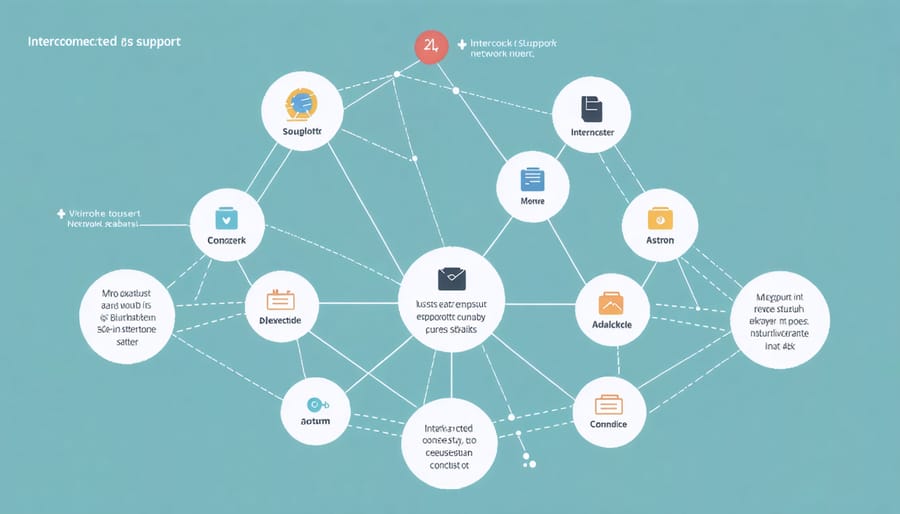Building resilient communities starts with understanding our shared vulnerability and collective strength. When we invest in creating support systems that can weather challenges – from natural disasters to economic hardships – we strengthen the fabric that holds our neighborhoods together.
Today’s communities face unprecedented challenges: climate change, social isolation, economic inequality, and mental health crises. Yet within these challenges lies an opportunity to forge stronger connections and develop innovative solutions that benefit everyone, particularly our young people who will inherit tomorrow’s world.
Research shows that communities with strong social networks, accessible resources, and collaborative problem-solving approaches recover faster from setbacks and adapt more effectively to change. This resilience isn’t just about surviving difficulties – it’s about emerging stronger, more connected, and better equipped to face future challenges.
By focusing on building inclusive support systems, fostering meaningful connections between neighbors, and developing practical emergency response plans, we can create communities that don’t just bounce back from adversity – they bounce forward. Whether you’re a parent, educator, community leader, or concerned citizen, your role in building community resilience is vital and starts with simple, everyday actions that create lasting impact.
This journey toward stronger communities begins with understanding the key building blocks of resilience and taking concrete steps to strengthen them together.
Understanding Social Network Gaps for At-Risk Youth
Common Social Support Challenges
Even the strongest communities face challenges in maintaining effective social support systems. One common gap is the inconsistency of available resources, where support services may be abundant during crisis periods but scarce during everyday situations. Many families report feeling isolated during transition periods, such as moving to a new neighborhood or when children change schools.
Transportation barriers often prevent families from accessing existing support services, particularly in rural or underserved areas. Cultural and language differences can create communication gaps between service providers and community members, leading to misunderstandings and reduced participation in support programs.
Another significant challenge is the “digital divide,” where some community members lack access to online resources and support networks. This became especially apparent during the COVID-19 pandemic, highlighting the need for both digital and in-person support options.
Time constraints also pose a major hurdle, as many parents juggle work commitments with family responsibilities, making it difficult to engage in community activities or access support services during traditional hours. Additionally, stigma around seeking help can prevent individuals from reaching out, even when services are readily available.
Impact of Weak Social Networks
When young people lack strong social connections, the impact can ripple through various aspects of their development. Research shows that children and teenagers who experience social isolation are more likely to struggle with emotional regulation, academic performance, and building trust in relationships.
Sarah Martinez, a youth counselor with 15 years of experience, shares, “I’ve seen how limited social support can affect a child’s confidence and willingness to try new things. Without a reliable support network, even simple challenges can feel overwhelming.”
The absence of meaningful social connections can lead to:
– Increased risk of anxiety and depression
– Difficulty developing social skills
– Lower academic achievement
– Reduced self-esteem
– Higher likelihood of engaging in risky behaviors
However, it’s important to remember that these effects aren’t permanent. Communities can actively work to create supportive environments where young people feel valued and connected. Something as simple as a caring mentor, an after-school program, or a neighborhood support group can make a significant difference in a young person’s life.
By recognizing these challenges early, we can take steps to strengthen social networks and provide the support youth need to thrive.
Core Components of Resilient Youth Networks

Trusted Adult Mentors
Having a trusted adult mentor can be transformative in a young person’s life, serving as an anchor during challenging times and a guide toward positive development. Research consistently shows that children who have at least one stable, caring adult in their lives are better equipped to overcome adversity and build resilience.
These mentors come in many forms – teachers, coaches, counselors, family friends, or community leaders. What matters most is their consistent presence and genuine commitment to supporting youth development. Effective adult mentors provide more than just guidance; they offer emotional support, model healthy behaviors, and help young people develop critical life skills.
Dr. Sarah Chen, a child development specialist, explains, “When children know they have someone reliable in their corner, someone who believes in them unconditionally, it creates a foundation of security that enables them to take positive risks and bounce back from setbacks.”
To foster these vital relationships, communities can:
– Establish formal mentoring programs in schools and youth organizations
– Train potential mentors in active listening and youth support techniques
– Create opportunities for natural mentoring relationships to develop
– Support existing mentors through resources and networking
Remember that mentoring relationships take time to develop. The most impactful connections often grow naturally through regular, meaningful interactions where adults demonstrate genuine interest in young people’s well-being and potential.
Peer Support Systems
Positive peer relationships form the backbone of resilient communities, creating networks of support that help young people navigate challenges and build confidence. Research consistently shows that when youth connect with supportive peers, they’re more likely to develop healthy coping mechanisms and maintain better mental health outcomes.
Dr. Sarah Chen, a child psychologist, shares, “I’ve seen remarkable transformations in young people when they’re surrounded by peers who understand their struggles. It creates a sense of belonging that’s absolutely crucial for emotional well-being.” Understanding the essential principles of peer support helps communities create effective mentoring programs and support groups.
Consider Maya’s story: After struggling with anxiety, she joined a youth support group at her local community center. “Finding friends who truly understood what I was going through changed everything,” she explains. “We lift each other up on tough days and celebrate our victories together.”
Successful peer support systems often include:
– Regular group activities that foster natural connections
– Structured mentoring programs pairing older and younger youth
– Safe spaces for open dialogue and emotional expression
– Ongoing training for peer mentors
– Adult supervision and guidance when needed
These systems work best when they’re sustained long-term and integrated into existing community structures, such as schools, youth centers, and sports programs. The key is creating opportunities for authentic connections while ensuring appropriate support and oversight.
Building Sustainable Support Systems
Community Integration Strategies
Creating meaningful connections between youth and community support services requires a thoughtful, coordinated approach. Start by identifying local resources such as youth centers, sports programs, mentorship opportunities, and mental health services. These connections serve as vital lifelines for young people seeking support and belonging.
Dr. Sarah Chen, a youth development specialist, shares: “The most successful community integration programs create multiple touchpoints for engagement. It’s not just about providing services; it’s about making young people feel genuinely welcomed and valued.”
Consider implementing these proven strategies:
– Partner with local schools to create after-school programs that connect students with community mentors
– Organize regular community events where youth can showcase their talents and contributions
– Establish peer support groups that help young people build social connections
– Create volunteer opportunities that allow youth to give back to their community
– Develop partnerships with local businesses to provide internship and job training programs
Remember to involve young people in the planning process. Their input helps ensure programs meet their actual needs and interests. As one teen participant notes, “When adults actually listen to our ideas, we feel more invested in making these programs work.”
Regular feedback sessions and adjustments based on youth input help maintain program effectiveness and engagement levels. This collaborative approach strengthens both individual resilience and community bonds.
School-Based Support Programs
Schools play a vital role in building community resilience by creating supportive environments where students, families, and staff can connect and thrive. Effective school-based support programs typically combine academic assistance with social-emotional learning and mental health services, creating a comprehensive safety net for vulnerable youth.
Many successful schools implement peer mentoring programs, where older students guide younger ones through academic and social challenges. These relationships not only help at-risk students feel more connected but also develop leadership skills in mentor students. As Maria Rodriguez, a high school counselor in Chicago, notes, “When students help other students, it creates a ripple effect of support throughout the entire school community.”
After-school programs provide another crucial layer of support, offering structured activities that keep students engaged while parents are working. These programs often include homework help, arts and crafts, sports, and life skills workshops. They create safe spaces where students can build positive relationships with caring adults and peers.
Family engagement initiatives are equally important. Schools that actively involve parents through regular communication, family nights, and parent education workshops see higher levels of student success and community involvement. Some schools have established family resource centers that connect parents with community services, job training, and educational opportunities.
Mental health support services, including on-site counselors and partnerships with local mental health providers, ensure students receive the emotional support they need to overcome challenges and build resilience.

Family Engagement Techniques
Building strong family connections is fundamental to community resilience. Research shows that families who spend quality time together and maintain open communication channels are better equipped to handle life’s challenges. One effective technique is establishing regular family meetings where everyone can share their thoughts, concerns, and celebrations in a safe space.
Creating family traditions and rituals, whether it’s Sunday dinners or monthly outings, helps strengthen bonds and create lasting memories. These shared experiences build emotional resilience and provide comfort during difficult times. Additionally, family engagement in education has proven to be crucial for children’s development and overall family well-being.
Consider implementing these practical strategies:
– Set aside dedicated “device-free” time for meaningful conversations
– Create a family gratitude practice
– Establish consistent routines for meals and bedtime
– Plan regular family activities that everyone enjoys
– Encourage open expression of feelings and active listening
Remember to adapt these techniques to your family’s unique needs and circumstances. What works for one family might need adjustment for another. The key is consistency and authenticity in your approach. When families feel supported and connected, they become stronger contributors to community resilience, creating a positive ripple effect throughout the neighborhood.
Supporting extended family connections and intergenerational relationships can also enhance family resilience. Consider involving grandparents, aunts, uncles, and cousins in family activities when possible, as these connections provide additional layers of support and wisdom.
Measuring Network Effectiveness

Success Indicators
When evaluating the effectiveness of community resilience initiatives, several key indicators help measure progress and impact. Active participation in community programs, increasing attendance at support group meetings, and growing volunteer engagement serve as positive signs of a strengthening network. Mental health professionals often look for improvements in youth emotional well-being, including reduced anxiety levels and enhanced coping skills.
Educational metrics, such as improved school attendance and academic performance, can reflect the success of support systems. Additionally, decreased rates of risky behaviors and increased participation in positive activities indicate program effectiveness. Strong partnerships between schools, healthcare providers, and community organizations demonstrate institutional buy-in and sustainability.
Family feedback surveys and youth self-assessments provide valuable insights into program impact. Success is also measured through the development of peer support networks, mentorship relationships, and leadership opportunities for young people. Regular monitoring of these indicators helps communities adjust their approaches and ensure resources are meeting actual needs.
Remember that building resilience is a gradual process, and even small improvements across these metrics represent meaningful progress toward stronger, more supportive communities.
Continuous Improvement Strategies
Building resilient communities requires ongoing dedication and adaptability. Start by regularly assessing current support systems through community surveys and feedback sessions. These evaluations help identify gaps and opportunities for improvement in existing programs.
Establish monthly community meetings where families, educators, and mental health professionals can collaborate on building stronger mental health networks for children. These gatherings create opportunities to share success stories, address challenges, and develop innovative solutions together.
Create mentorship programs that pair experienced community members with newcomers, ensuring knowledge and resources are effectively passed on. This approach helps maintain continuity while bringing fresh perspectives to existing support systems.
Consider implementing a quarterly review system to track progress and adjust strategies as needed. Document successful initiatives and learn from less effective ones. Remember that improvement is a journey, not a destination. Celebrate small wins and use setbacks as learning opportunities to strengthen your community’s foundation.
Encourage active participation by recognizing volunteer efforts and sharing positive outcomes through community newsletters or social media. This recognition helps maintain motivation and inspires others to contribute to the collective well-being of our youth.
Building community resilience is a journey that requires dedication, collaboration, and unwavering commitment from all stakeholders. Throughout this guide, we’ve explored the essential components of creating stronger, more supportive communities for our youth. From establishing mentorship programs to developing crisis response systems, each step plays a vital role in fostering resilience.
Remember that small actions can create significant impact. Whether you’re a parent supporting your child’s emotional growth, a teacher implementing trauma-informed practices in your classroom, or a healthcare professional connecting families with resources, your contributions matter. The strength of our community lies in our ability to work together and support one another.
As we move forward, let’s commit to taking concrete steps toward building more resilient communities. Start by identifying one area where you can make a difference – perhaps by volunteering at a local youth center, organizing a community support group, or advocating for better mental health resources in schools. Share your knowledge and experiences with others, and encourage them to join in these efforts.
Remember that building resilience is not a destination but an ongoing process. By staying informed, maintaining open communication, and consistently showing up for our youth, we create the foundation for lasting positive change. Together, we can build communities that not only weather challenges but emerge stronger and more united than before.
Take that first step today. Our children’s future depends on the actions we take now to create more resilient, supportive, and nurturing communities.







